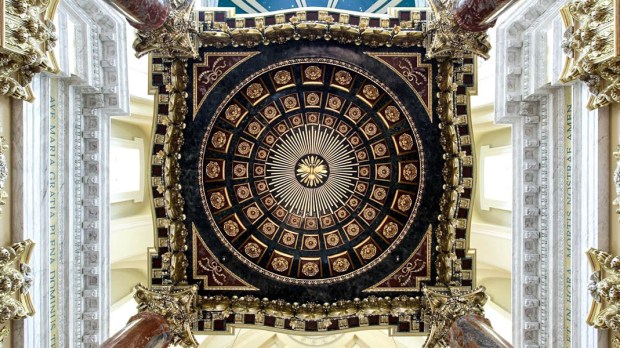Lenten Campaign 2025
This content is free of charge, as are all our articles.
Support us with a donation that is tax-deductible and enable us to continue to reach millions of readers.
When entering an older church or cathedral, you will often see a large architectural structure that hangs over the main altar (or sometimes over the high altar against the wall). Its prominence draws the attention of the visitor and focuses it on the most important part of the church.
This structure is commonly called the baldacchino or sometimes referred to as the ciborium. Essentially it is a stationary canopy supported by four columns and stands directly over the main altar. In many churches the canopy only has two columns and is fixed against the wall.
Beginning in the 4th century baldacchinos were primarily constructed for large churches where the altar could easily be lost in the immense space.
Initially the columns of the canopy would also have moveable curtains. This was partially inspired by the Jewish Temple where a veil separated the Holy of Holies.
At times the curtains would completely obscure the view of the congregation (similar to the Byzantine iconostasis), while at other times during the liturgy they would be lifted back. This corresponds to the inauguration of the New Covenant brought about through Jesus Christ’s sacrifice on the cross and recalls the moment when “the curtain of the temple was torn in two.” (Matthew 27:51)
Some spiritual writers have also pointed to the similarity of the baldacchino to the Jewish chuppah. According to Maurice Lamm, the chuppah has great significance in Jewish culture.
The chuppah is a tapestry attached to the tops of four poles. The word chuppah means covering or protection, and is intended as a roof or covering for the bride and groom at their wedding … It is the decisive act that formally permits the couple’s new status of marriage to be actualized, and it is the legal conclusion of the marriage process that began with betrothal. Chuppah symbolizes the groom’s home, and the bride’s new domain. More specifically, the chuppah symbolizes the bridal chamber, where the marital act was consummated in ancient times.
In this context the baldacchino of Christian churches emphasizes the place where the bridegroom (Jesus) encounters his bride (the Church) and pledges his everlasting love. It further links the sacrament of Matrimony with the Holy Eucharist and recalls the words of St. Paul.
Husbands, love your wives, as Christ loved the church and gave himself up for her, that he might sanctify her, having cleansed her by the washing of water with the word, that he might present the church to himself in splendor, without spot or wrinkle or any such thing, that she might be holy and without blemish. (Ephesians 5:25-27)
The baldacchino is a marvelous architectural structure, one with a rich history and full of symbolism.

Read more:
What is the difference between a basilica and a cathedral?

